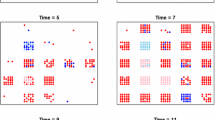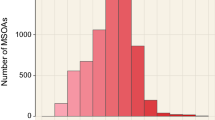Abstract
Spatial and spatio-temporal disease mapping models are widely used for the analysis of registry data and usually formulated in a hierarchical Bayesian framework. Explanatory variables can be included by a so-called ecological regression. It is possible to assume both a linear and a nonparametric association between disease incidence and the explanatory variable. Integrated nested Laplace approximations (INLA) can be used as a tool for Bayesian inference. INLA is a promising alternative to Markov chain Monte Carlo (MCMC) methods which provides very accurate results within short computational time. It is shown in this paper, how parameter estimates for well-known spatial and spatio-temporal models can be obtained by running INLA directly in \({\texttt{R}}\) using the package \({\texttt{INLA}}\). Selected \({\texttt{R}}\) code is shown. An emphasis is given to the inclusion of an explanatory variable. Cases of Coxiellosis among Swiss cows from 2005 to 2008 are used for illustration. The number of stillborn calves is included as time-varying covariate. Additionally, various aspects of INLA such as model choice criteria, computer time, accuracy of the results and usability of the \({\texttt{R}}\) package are discussed.
Similar content being viewed by others
References
Aitken I (1989) Clinical aspects and prevention of Q fever in animals. Eur J Epidemiol 5(4): 420–424
Assunção R, Reis I, Oliveira C (2001) Diffusion and prediction of leishmaniasis in a large metropolitan area in Brazil with a Bayesian space-time model. Stat Med 20(15): 2319–2335
Banerjee S, Carlin B, Gelfand A (2004) Hierarchical modeling and analysis for spatial data. Chapman & Hall/CRC, London
Bernardinelli L, Clayton D, Montomoli C (1995) Bayesian estimates of disease maps: how important are priors?. Stat Med 14: 2411–2431
Bernardinelli L, Clayton D, Pascutto C, Montomoli C, Ghislandi M (1995) Bayesian analysis of space-time variation in disease risk. Stat Med 14: 2433–2443
Berzuini C, Clayton D (1994) Bayesian analysis of survival on multiple time scales. Stat Med 13: 823–838
Besag J, York J, Mollié A (1991) Bayesian image restoration with two applications in spatial statistics. Ann Inst Stat Math 43(1): 1–59
Clayton D, Bernardinelli L (1992) Bayesian methods for mapping disease risk. In: Cuzick J (ed) et al Geographical and environmental epidemiology. Methods for small area studies. Oxford University Press, Oxford, pp 205–220
Clayton D, Bernardinelli L, Montomoli C (1993) Spatial correlation in ecological analysis. Int J Epidemiol 22(6): 1193–1202
Czado C, Gneiting T, Held L (2009) Predictive model assessment for count data. Biometrics 65(4): 1254–1261
Dupuis G, Petite J, Péter O, Vouilloz M (1987) An important outbreak of human Q fever in a Swiss alpine valley. Int J Epidemiol 16(2): 282–287
Fahrmeir L, Lang S (2001) Bayesian inference for generalized additive mixed models based on Markov random field priors. J R Stat Soc Ser C 50(2): 201–220
Gneiting T, Raftery AE (2007) Strictly proper scoring rules, prediction, and estimation. J Am Stat Assoc 102(477): 359–378
Held L, Schrödle B, Rue H (2010) Posterior and cross-validatory predictive checks: a comparison of MCMC and INLA. In: Kneib T, Tutz G (eds) Statistical modelling and regression structures—Festschrift in honour of Ludwig Fahrmeir. Physica-Verlag, Heidelberg
Knorr-Held L (2000) Bayesian modelling of inseparable space-time variation in disease risk. Stat Med 19: 2555–2567
Kullback S, Leibler R (1951) On information and sufficiency. Ann Math Stat 22(1): 79–86
Lindgren F, Rue H (2008) On the second-order random walk model for irregular locations. Scand J Stat 35: 691–700
Martino S, Rue H (2009) Implementing approximate Bayesian inference using Integrated Nested Laplace Approximation: A manual for the \({\texttt{INLA}}\) program. Technical report, Norwegian University of Science and Technology Trondheim
Moreno P, Ho P, Vasconcelos N (2004) A Kullback-Leibler divergence based kernel for SVM classification in multimedia applications. In: Thrun S, Saul L, Schölkopf B (eds) Advances in neural information processing systems 16. MIT Press, Cambridge
Natario I, Knorr-Held L (2003) Non-parametric ecological regression and spatial variation. Biom J 45(6): 670–688
R Development Core Team (2005) R: a language and environment for statistical computing. R Foundation for Statistical Computing, Vienna, Austria, http://www.R-project.org, ISBN 3-900051-07-0
Rue H, Held L (2005) Gaussian Markov random fields. Chapman & Hall/CRC, London
Rue H, Martino S (2007) Approximate Bayesian inference for hierarchical Gaussian Markov random field models. J Stat Plan Inference 137: 3177–3192
Rue H, Martino S, Chopin N (2009) Approximate Bayesian inference for latent Gaussian models by using integrated nested Laplace approximations (with discussion). J R Stat Soc Ser B 71: 319–392
Schmid V, Held L (2004) Bayesian extrapolation of space-time trends in cancer registry data. Biometrics 60: 1034–1042
Schrödle B, Held L, Riebler A, Danuser J (2010) Using INLA for the evaluation of veterinary surveillance data from Switzerland: a case study. Technical report, University of Zurich
Spiegelhalter D, Best N, Carlin B, van der Linde A (2002) Bayesian measures of model complexity and fit (with discussion). J R Stat Soc Ser B 64(4): 583–639
Tierney L, Kadane JB (1986) Accurate approximations for posterior moments and marginal densities. J Am Stat Assoc 81(393): 82–86
Woldehiwet Z (2004) Q fever (Coxiellosis): epidemiology and pathogenesis. Res Vet Sci 77(2): 93–100
Wood S, Kohn R (1998) A Bayesian approach to robust binary nonparametric regression. J Am Stat Assoc 93(441): 203–213
Author information
Authors and Affiliations
Corresponding author
Electronic Supplementary Material
The Below is the Electronic Supplementary Material.
Rights and permissions
About this article
Cite this article
Schrödle, B., Held, L. A primer on disease mapping and ecological regression using \({\texttt{INLA}}\) . Comput Stat 26, 241–258 (2011). https://doi.org/10.1007/s00180-010-0208-2
Received:
Accepted:
Published:
Issue Date:
DOI: https://doi.org/10.1007/s00180-010-0208-2




